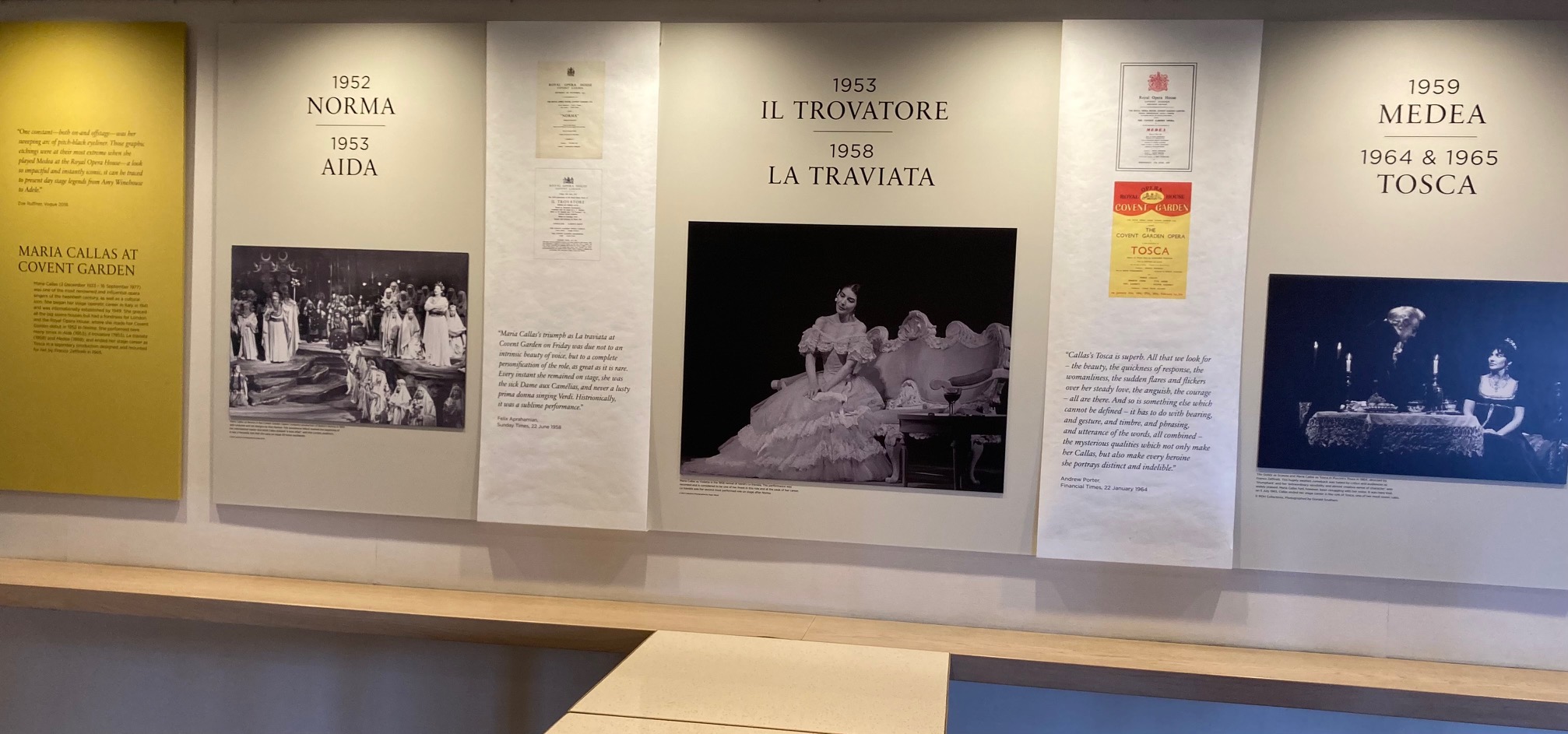
Yesterday I made the short journey into town to visit the Maria Callas at Covent Garden exhibition, which I’d read about in Gramophone. According to the press release,
the display will feature a collection of rare images and stories from Callas’s time at the Royal Opera House, offering a fascinating glimpse into the career of the Covent Garden icon. … Callas at Covent Garden will highlight milestones from this career through photographs and anecdotes as well as exploring her unique personal style, which continues to influence stage performers in the modern day, and is cited as ‘iconic’ by leading fashion house Vogue.
The photograph above is of the entire “exhibition”. This paltry display looked no better than a school project. The three photos used are not in the least bit rare. Even the short biographical blurb was incorrect, citing 1941 as the year of her Italian debut. Quite honestly, if I’d been the teacher marking this project, they would have got a C-. For the record, in 1941 she was still studying with Elvira De Hidalgo in Greece and only turned eighteen at the end of that year. She had just joined the national opera company (the National Lyric Theatre of Greece) singing one role with them in 1941, the role of Beatrice in Suppé’s Boccaccio. Her Italian debut came in 1947, when she sang Gioconda under the baton of Tullio Serafin, who was to become her mentor and was extremely influential in her career.
Callas’s Covent Garden career certainly deserves to be celebrated, as the London audiences were particularly appreciative and she always enjoyed appearing there and had an excellent relationship with the company. She first appeared in London in November1952, receiving rapturous reviews for her performance of the title role in Norma, a performance that has fortunately been preserved in sound. You can read my review of the Warner release of the live recording here. It features the great mezzo Ebe Stignani as Adalgisa and was conducted by Vittorio Gui. Joan Sutherland even played the minor role of Clotilde. She returned the following season, when she was partnered by Giulietta Simionato in Aida (with Barbirolli, no less, in the pit), Norma again and Il Trovatore. Although she again was accorded a fabulous reception, her Leonora in Il Trovatore being particularly well received, she did not appear at the house again until 1957, having lost a significant amount of weight in the interim. She again sang Norma to the Adalgisa of Ebe Stignani. Such was the reception accorded to them, that Sir John Pricthard, who was conducting, granted an unprecedented encore of Mira, o Norma.
She returned in 1958 to sing legendary performances of Violetta in La Traviata. One of the performances was recorded by the BBC and is considered by most Callas afficionados the greatest of all her recorded Violettas. You can read my review of the recording here.
Then in 1959, in an exchange with the Dallas Opera, she sang in Alexis Minotis’s production of Cherubini’s Medea, an opera that had never before been staged at the Royal Opera House. By this time her career was winding down and in fact she didn’t set foot on the operatic stage at all in 1962 and 1963, apart from a couple of performances of Medea at La Scala in May of 1962. It was Franco Zeffirelli, who lured her back onto the stage and in January of 1964 she returned to the stage in Tosca, with Tito Gobbi as Scarpia, in a now legendary production of the opera that remained in the repertoire of the Royal Opera until 2005. So powerful was the alchemy that existed between Callas and Gobbi that those who saw the production talked about it for decades afterwards. It was broadcast on the radio by the BBC (a performance that is now available from Warner Classics, which I review here). Act II was filmed by ATV (how sad that they didn’t record the whole thing), a superb memento of two towering figures of the operatic stage. If anyone doubts the validity of opera as drama, then they should definitely watch this. You can see it on youtube here.
Callas’s operatic comeback was short-lived. After gruelling performances of Norma in 1965, the last of which she was unable to complete, she was advised by her doctor to cancel all future engagements. She had been scheduled to sing four performances of Tosca at Covent Garden, but pulled out, agreeing to sing just one, which was a Royal Charity Gala. According to those who saw it, she was still mesmerising, but her voice was quite restricted in volume. It was the last time she ever sang in a complete opera, either on stage or in the studio.
All of her appearances at Covent Garden have been well documented and it is easy to find a wealth of photographs, performance reviews and personal reminisences by people who worked with her or saw some of those performances. Why didn’t the Royal Opera House draw on any of these? What they did do dishonours the memory of arguably the greatest opera singer of the tewntieth century.
I should also spare a thought for Victoria De Los Angeles, a Covent Garden favourite, whose centenary is also being celebrated this year. All the Royal Opera could afford her was a single photograph accompanied by a shamefully brief bio, tacked onto the end of the Callas display.
Fortunately I live close to Covent Garden. If anyone further afield has seen any of the blurb in Gramophone magazine or elsewhere and is contemplating a visit, I’d just say, “Don’t bother.”
Covent Garden seems to have thrown this together. She was dominant as a soprano for twenty years and her achievements deserve more than this. Thank goodness we have Philip to remind us of her worth.
LikeLiked by 1 person